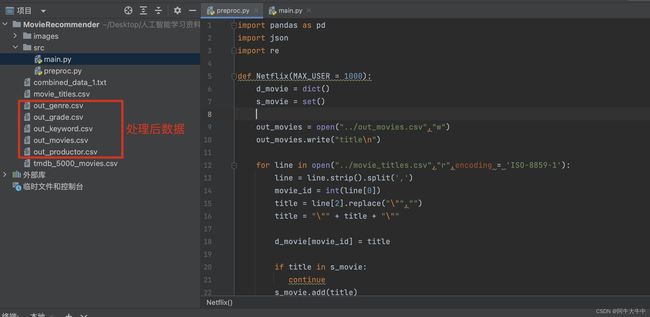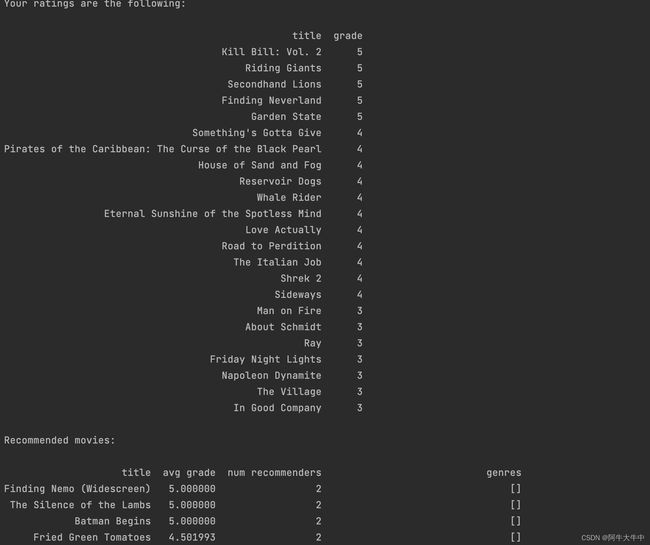基于知识图谱的电影推荐系统——Neo4j&Python
文章目录
- 1. 数据解下载与配置
- 2. 将处理好的数据导入数据库中
- 3. 执行项目
1. 数据解下载与配置
选择TMDB电影数据集,Netflix Prize 数据集下载。
也可直接从这里下载:链接: https://pan.baidu.com/s/1l6wjwcUzy5G_dIlVDbCkpw 提取码: pkq6 。
执行preproc.py文件,进行数据预处理,生成5个处理后的文件:
import pandas as pd
import json
import re
def Netflix(MAX_USER = 1000):
d_movie = dict()
s_movie = set()
out_movies = open("../out_movies.csv","w")
out_movies.write("title\n")
for line in open("../movie_titles.csv","r",encoding = 'ISO-8859-1'):
line = line.strip().split(',')
movie_id = int(line[0])
title = line[2].replace("\"","")
title = "\"" + title + "\""
d_movie[movie_id] = title
if title in s_movie:
continue
s_movie.add(title)
out_movies.write(f"{title}\n")
out_movies.close()
out_grade = open("../out_grade.csv","w")
out_grade.write("user_id,title,grade\n")
files = ["../combined_data_1.txt"]
for f in files:
movie_id = -1
for line in open(f,"r"):
pos = line.find(":")
if pos != -1: # is a new user
movie_id = int(line[:pos])
continue
line = line.strip().split(",")
user_id = int(line[0])
rating = int(line[1])
if user_id > MAX_USER:
continue
out_grade.write(f"{user_id},{d_movie[movie_id]},{rating}\n")
out_grade.close()
def TMDB():
pattern = re.compile("[A-Za-z0-9]+")
# 提取电影类型
out_genre = open("../out_genre.csv","w",encoding='utf-8')
out_genre.write("title,genre\n")
# 提取电影关键词
out_keyword = open("../out_keyword.csv","w",encoding='utf-8')
out_keyword.write("title,keyword\n")
# 提取电影制片人
out_productor = open("../out_productor.csv","w",encoding='utf-8')
out_productor.write("title,productor\n")
df = pd.read_csv("../tmdb_5000_movies.csv", sep=",")
json_columns = ['genres', 'keywords', 'production_companies']
for column in json_columns:
df[column] = df[column].apply(json.loads)
df = df[["genres", "keywords", "original_title","production_companies"]]
for _, row in df.iterrows():
title = row["original_title"]
if not pattern.fullmatch(title):
continue
title = "\"" + title + "\""
for g in row["genres"]:
genre = g["name"]
genre = "\"" + genre + "\""
out_genre.write(f"{title},{genre}\n")
for g in row["keywords"]:
keyword = g["name"]
keyword = "\"" + keyword + "\""
out_keyword.write(f"{title},{keyword}\n")
for g in row["production_companies"]:
productor = g["name"]
productor = "\"" + productor + "\""
out_productor.write(f"{title},{productor}\n")
if __name__ == "__main__":
Netflix()
TMDB()
2. 将处理好的数据导入数据库中
将上面数据预处理生成的5个文件,放入import文件夹中:
3. 执行项目
修改main.py中的driver,输入自己数据库的用户名与密码。
执行main.py文件:
from neo4j import GraphDatabase
import pandas as pd
uri = "neo4j://localhost:7687"
driver = GraphDatabase.driver(uri, auth=("neo4j", "Liu881389."))
k = 10 # nearest neighbors (most similar users) to consider
movies_common = 3 # how many movies in common to be consider an user similar
users_common = 2 # minimum number of similar users that have seen the movie to consider it
threshold_sim = 0.9 # threshold to consider users similar
def load_data():
with driver.session() as session:
session.run("""MATCH ()-[r]->() DELETE r""")
session.run("""MATCH (r) DELETE r""")
print("Loading movies...")
#加载数据,创建Movie标签,title属性的实体
session.run("""
LOAD CSV WITH HEADERS FROM "file:///out_movies.csv" AS csv
CREATE (:Movie {title: csv.title})
""")
print("Loading gradings...")
#加载评分数据,MERGE是搜索给定模式,如果存在,则返回结果如果它不存在于图中,则它创建新的节点/关系并返回结果。
session.run("""
LOAD CSV WITH HEADERS FROM "file:///out_grade.csv" AS csv
MERGE (m:Movie {title: csv.title})
MERGE (u:User {id: toInteger(csv.user_id)})
CREATE (u)-[:RATED {grading : toInteger(csv.grade)}]->(m)
""")
#加载影片类型数据
print("Loading genres...")
session.run("""
LOAD CSV WITH HEADERS FROM "file:///out_genre.csv" AS csv
MERGE (m:Movie {title: csv.title})
MERGE (g:Genre {genre: csv.genre})
CREATE (m)-[:HAS_GENRE]->(g)
""")
print("Loading keywords...")
#加载关键词数据
session.run("""
LOAD CSV WITH HEADERS FROM "file:///out_keyword.csv" AS csv
MERGE (m:Movie {title: csv.title})
MERGE (k:Keyword {keyword: csv.keyword})
CREATE (m)-[:HAS_KEYWORD]->(k)
""")
print("Loading productors...")
#制片人
session.run("""
LOAD CSV WITH HEADERS FROM "file:///out_productor.csv" AS csv
MERGE (m:Movie {title: csv.title})
MERGE (p:Productor {name: csv.productor})
CREATE (m)-[:HAS_PRODUCTOR]->(p)
""")
def queries():
while True:
userid = int(input("请输入要为哪位用户推荐电影,输入其ID即可: "))
m = int(input("为该用户推荐多少个电影呢? "))
genres = []
if int(input("是否需要过滤掉不喜欢的类型?(输入0或1)")):#过滤掉不喜欢的类型
with driver.session() as session:
try:
q = session.run(f"""MATCH (g:Genre) RETURN g.genre AS genre""")
result = []
for i, r in enumerate(q):
result.append(r["genre"])#找到图谱中所有的电影类型
df = pd.DataFrame(result, columns=["genre"])
print()
print(df)
inp = input("输入不喜欢的类型索引即可,例如:1 2 3 ")
if len(inp) != 0:
inp = inp.split(" ")
genres = [df["genre"].iloc[int(x)] for x in inp]
except:
print("Error")
with driver.session() as session:#找到当前ID评分的电影
q = session.run(f"""
MATCH (u1:User {{id : {userid}}})-[r:RATED]-(m:Movie)
RETURN m.title AS title, r.grading AS grade
ORDER BY grade DESC
""")
print()
print("Your ratings are the following:")
result = []
for r in q:
result.append([r["title"], r["grade"]])
if len(result) == 0:
print("No ratings found")
else:
df = pd.DataFrame(result, columns=["title", "grade"])
print()
print(df.to_string(index=False))
print()
session.run(f"""
MATCH (u1:User)-[s:SIMILARITY]-(u2:User)
DELETE s
""")
#找到当前用户评分的电影以及这些电影被其他用户评分的用户,with是把查询集合当做结果以便后面用where 余弦相似度计算
session.run(f"""
MATCH (u1:User {{id : {userid}}})-[r1:RATED]-(m:Movie)-[r2:RATED]-(u2:User)
WITH
u1, u2,
COUNT(m) AS movies_common,
SUM(r1.grading * r2.grading)/(SQRT(SUM(r1.grading^2)) * SQRT(SUM(r2.grading^2))) AS sim
WHERE movies_common >= {movies_common} AND sim > {threshold_sim}
MERGE (u1)-[s:SIMILARITY]-(u2)
SET s.sim = sim
""")
Q_GENRE = ""
if (len(genres) > 0):
Q_GENRE = "AND ((SIZE(gen) > 0) AND "
Q_GENRE += "(ANY(x IN " + str(genres) + " WHERE x IN gen))"
Q_GENRE += ")"
#找到相似的用户,然后看他们喜欢什么电影 Collect:将所有值收集到一个集合list中
q = session.run(f"""
MATCH (u1:User {{id : {userid}}})-[s:SIMILARITY]-(u2:User)
WITH u1, u2, s
ORDER BY s.sim DESC LIMIT {k}
MATCH (m:Movie)-[r:RATED]-(u2)
OPTIONAL MATCH (g:Genre)--(m)
WITH u1, u2, s, m, r, COLLECT(DISTINCT g.genre) AS gen
WHERE NOT((m)-[:RATED]-(u1)) {Q_GENRE}
WITH
m.title AS title,
SUM(r.grading * s.sim)/SUM(s.sim) AS grade,
COUNT(u2) AS num,
gen
WHERE num >= {users_common}
RETURN title, grade, num, gen
ORDER BY grade DESC, num DESC
LIMIT {m}
""")
print("Recommended movies:")
result = []
for r in q:
result.append([r["title"], r["grade"], r["num"], r["gen"]])
if len(result) == 0:
print("No recommendations found")
print()
continue
df = pd.DataFrame(result, columns=["title", "avg grade", "num recommenders", "genres"])
print()
print(df.to_string(index=False))
print()
if __name__ == "__main__":
if int(input("是否需要重新加载并创建知识图谱?(请选择输入0或1)")):
load_data()
queries()
运行main.py文件后:
![]()
系统会询问是否需要重新加载并创建知识图谱,在第一次时输入1。
加载完成后可以在neo4j中查看:
接下来输入需要查询的信息:
输出结果:








